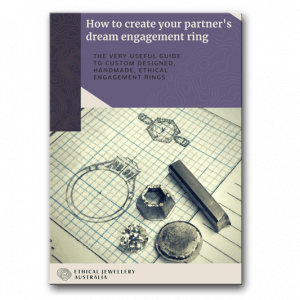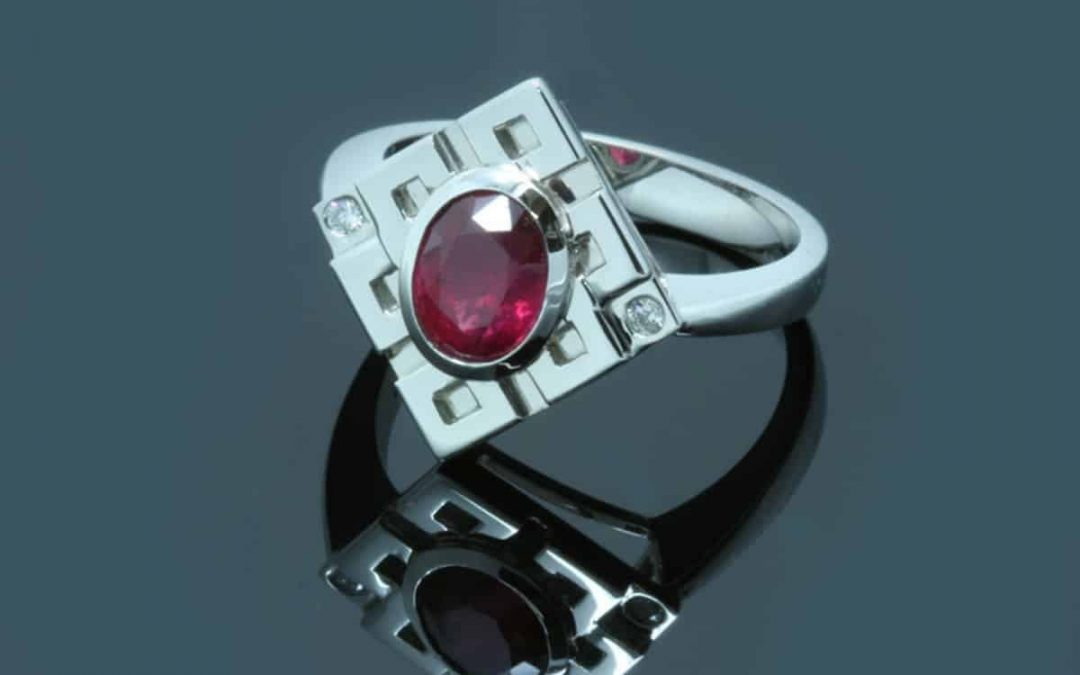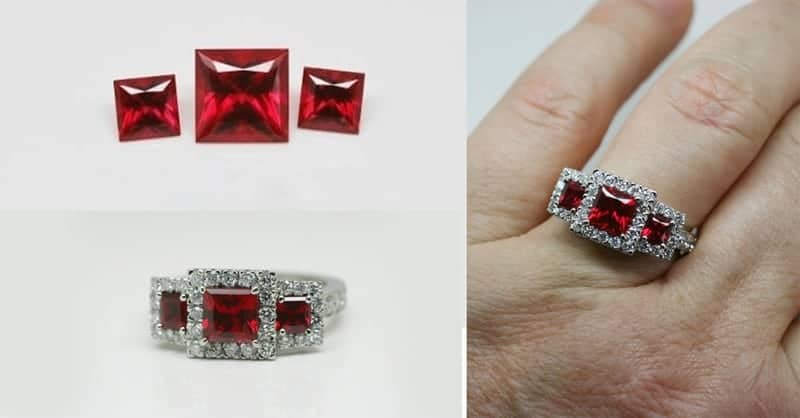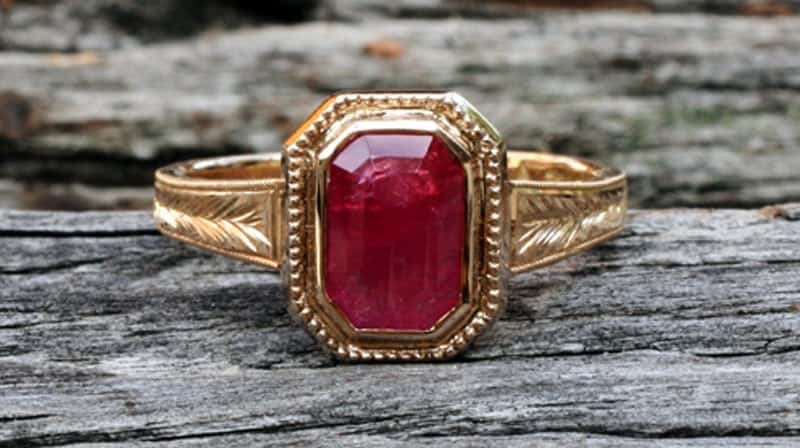As I recall it, looking back now at the movies and books I was into when I was a lot younger, pretty much every bit of treasure was described as being ‘ruby-encrusted’. Whether that was in a pirate’s chest or set in a crown, a scepter, a bracelet or some other quest-worthy valuable. (I remember emeralds got a mention too, but rubies were all the rage, so it seems.)
Until De Beers successfully marketed them back in the 1930s and 40s, diamonds weren’t really that big a deal. Before then, ostentatious wealth and prestige was all about gold, silver and coloured gemstones. And rubies were front and center.
History and Significance
There’s a lot to be said about rubies, but rather than wax lyrical, let’s chunk it down into bite-sized pieces for you.
- Birthstone for July: According to wonderopolis.org the notion of various gemstones being linked to months of birth is probably biblical in origin. Associated with a gem-studded high priest’s breastplate representing the 12 tribes of Israel. This may then have transferred to the Zodiac symbology and thus to birth month;
- Anniversary gemstone – 15th and 40th: The origin of gift-giving to celebrate an anniversary is not well known, but probably dates back to Roman times (https://en.wikipedia.org/wiki/Wedding_anniversary ). Specific gifts or gift types were assigned by year only in recent (more commercialised) times;
- The name ruby comes from the Latin word ruber, meaning “red”. The colour is associated with many powerful feelings and emotions such as anger, pain, danger, strength, fire and heat. (Importantly, fire engines are red, and everyone “knows” red cars are the fastest!);
- The ancient Burmese believed rubies would bestow invulnerability upon its warriors. But only if the stone was inserted into the flesh, not just worn externally;
- The Hindu religion describes rubies as “the king of precious stones”. The Kalpa Tree – a symbolic offering to the Hindu gods – was apparently made entirely of precious stones including sapphires, diamonds, topaz and emeralds and would bear rubies as fruit;
- In an 8th Century Arabic book, Achametis detailed that a king dreaming of a crown set with red jewels such as rubies was a good omen, foretelling great joy and fortune; and
- Ironically, one of the world’s most famous rubies – the Black Prince’s Ruby, set at the front of the Imperial State Crown of England – is, in fact, a spinel.
There are many more mentions of rubies in history and various folk lore and mythology, but you probably get the idea. Rubies were (and still are) a big deal.
In fact, fine rubies are, by weight, some of the most expensive gemstones you can buy!
Gemmology
Ruby is the red variation of Corundum, the red colour being attributed to the presence of chromium. (Sapphire is also Corundum – appearing in blues, pinks, yellows, orange, greens, purples and as a colourless gem.)
It has a hardness of 9.0 on Moh’s Scale, making it quite suitable for use in jewellery worn day to day.
Jewellery-quality rubies have been found in Afghanistan, Myanmar (formerly Burma – producing the famed ‘pigeon blood’ ruby), Cambodia, Pakistan, Sri Lanka, Madagascar, Namibia, Tanzania, Malawi, Kenya, Thailand and Vietnam.
Small quantities of rubies can be found in the USA and Australia. More recently, Greenland has started commercial production.
Inclusions are normal and vary with point of origin. Apart from the most common rutile (needle form), you can also find calcite, sphene, zircon, pyrite, biotite mica, almandine, apatite and boehmite..
Synthetics
Ruby was the first gemstone to have been synthesised in a laboratory, most famously in the late 1800s by Auguste Verneuil. The Verneuil Process (or Flame Fusion Process).
This is the least expensive, fastest and most common method of production. Other methods include Flux Growth and Crystal Pulling, both of which are much slower and more capital intensive. These processes produce much higher quality (and more expensive) synthetic gems.
Synthetics are relatively easy to identify, having relatively few inclusions. Virtually none feature rutile (the most common inclusion in natural ruby).
Ethics
It is important to consider the ecological impact and social ethics in the mining and distribution of natural rubies.
Corruption, conflict, criminal activity, habitat destruction and human rights abuses are all (unfortunately) common in gem-producing developing nations. That is not to say that within these regions there is not good work being done. Organisations like PACT are working within mining communities.
It’s crucial to develop strong relationships with a transparent supply chain to ensure that as much as possible is known about the origin, the energy and other costs of the gemstones that will be used in jewellery. Especially when that jewellery is meant to reflect a loving relationship.
At Ethical Jewellery Australia, we are extremely cautious in our choice of supplier when it comes to rubies. When we do source rubies for our customers we offer only fair trade, recycled (vintage) or high quality lab-grown. This does limit our options from time to time, but it’s not something we can (or will) compromise on.
Getting in touch
If you’d like to chat with us about having your special piece of jewellery (ruby encrusted or not) handmade by us, feel free to get in touch by email or phone. You can also check out our other work via our Instagram feed.
About EJA
Ethical Jewellery Australia is an online engagement and wedding ring specialist. Every ring is custom designed and made to order.
Customers are taken through the whole process from design to sourcing and finally to manufacturing.
All rings are handmade in Australia with recycled metals. (We can also supply Fair Trade gold if requested.)
Likewise, we only every use ethically sourced diamonds and gemstones. You can choose from Argyle, recycled, vintage and lab grown diamonds, Australian, US, Fair Trade, recycled and lab grown coloured gemstones.
By the way, we offer an Australia-wide service.
If you would like to learn how to start your engagement ring design adventure, get in touch today.
 If you would like to learn more about designing an engagement ring, download a copy of our free 70+ page design guide.
If you would like to learn more about designing an engagement ring, download a copy of our free 70+ page design guide.
About the Author: Benn Harvey-Walker
Benn is a Co-founder of Ethical Jewellery Australia and a keen student of ethical and sustainability issues in the jewellery world. He has a long history in sales and marketing and began working with EJA full time in early 2018.
Benn co-authored the original Engagement Ring Design Guide in 2014 and edited the 2nd Edition in 2018. He is also the principal author of the wedding and commitment ring design guide.
His main responsibilities at EJA are business development and sales process management. Benn also creates technical drawings for our ring designs.




Recent Comments